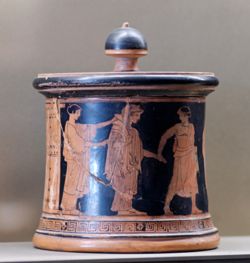.gif)
Pyxis (pottery)
Encyclopedia

Pottery of Ancient Greece
As the result of its relative durability, pottery is a large part of the archaeological record of Ancient Greece, and because there is so much of it it has exerted a disproportionately large influence on our understanding of Greek society...
, but especially in later periods may be in wood, metal, ivory
Ivory
Ivory is a term for dentine, which constitutes the bulk of the teeth and tusks of animals, when used as a material for art or manufacturing. Ivory has been important since ancient times for making a range of items, from ivory carvings to false teeth, fans, dominoes, joint tubes, piano keys and...
, or other materials. The name derived from Corinthian boxes made of wood from the tree puksos (boxwood
Buxus sempervirens
Buxus sempervirens is a flowering plant in the genus Buxus, native to western and southern Europe, northwest Africa, and southwest Asia, from southern England south to northern Morocco, and east through the northern Mediterranean region to Turkey. Buxus colchica of western Caucasus and B...
), that also came with covers. The shape of the vessel can be traced in pottery back to the Protogeometric period in Athens, however the Athenian pyxis has various shapes itself. At first, the two varieties of pyxis included the pointed and the flat-bottomed. The pointed pyxis didn't last much longer than the ninth century BCE, while the flat-bottomed continued into the late Geometric. It also continued to grow larger and more squat in proportions. The cover often depicts elaborately sculpted handles and the walls tend to be somewhat convex. During the sixth century BCE, however, Athens began producing boxes with concave walls that enabled them to be grasped easily when ranged close together on a shelf. Images on the pyxis usually depict the marriage procession from a young girl's house to that of her new husband.
Pyx
Pyx
A pyx or pix is a small round container used in the Catholic, Old Catholic and Anglican Churches to carry the consecrated host , to the sick or invalid or those otherwise unable to come to a church in order to receive Holy Communion...
is a term for a specifically liturgical box, usually round, but of variable design, still used for holding and transporting consecrated hosts
Sacramental bread
Sacramental bread, sometimes called the lamb, altar bread, host or simply Communion bread, is the bread which is used in the Christian ritual of the Eucharist.-Eastern Catholic and Orthodox:...
in the traditional Christian churches, a use to which the church began to put these boxes at a very early date.

